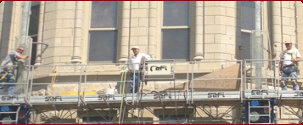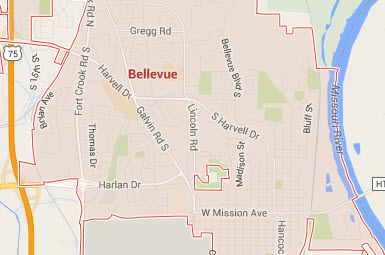Mortar Repair
Mortar is the material used for bedding, jointing and rendering brickwork and stonework. Mortar consists of lime, cement and sand.
Prior to the advent of portland cement in the United States in the latter part of the 19th century all of the masonry mortar was a straight lime-sand mix that possessed very low compressive strength. The low compressive strength of this softer mortar allowed for movement, contraction and expansion of the masonry and aided in controlling cracking or delaminating of the masonry. Lime slowly gain strength overtime in the masonry wall, absorbing CO2 from the air and converting itself back to limestone. As the lime absorbs CO2 from the air, the masonry wall gains an extra benefit. If a hairline crack develops between the brick and mortar joint, the lime acts as a "self healer" and sealing the cracks in a process identified as autogenous healing.
Ottobein 3.5 Natural Hydraulic Lime is our choice of lime for our historical projects. NHL Lime has a minimum compressive strength of 508 psi in 28 days. In 1818 while building the Erie Canal a limestone deposit contaminated with clay was discovered. When this impure stone was ground into powder form it gave birth to the term "natural" cement as it was naturally occurring obtained directly from the earth.
Analyzing or testing a mortar for the correct compressive strength is so critical to a successful restoration project. Consider the following differences in compressive strength of portland cement and also of the most common mortars used today.
When trying to match a portland cement mortar between 1871 and 1920 into today's times there are compressive strength issues to be considered. Today's portland is burned at a much higher temperatures than portland from 1871. In 1871 portland cement tested in the 1800 psi range and today's portland cement can be in the 8000 psi range. Indeed the portland cement of 1871 bears more relation to a modern higher strength hydraulic lime mortar than it does to modern portland cement.
Modern mortars follow ASTM (American Society Testing Materials) guidelines for minimum required compressive strength for the various mortar types. To meet this requirement the mix has to just be at or above the minimum psi but can be considerably higher.
ASTM Minimums for Compressive Strength
Type M 2500 psi
Type S 1800 psi
Type N 750 psi
Type O 350 psi
Type K 75 psi
Type K is mentioned but it is a historical restoration mortar.
But be careful these mortar mixes can have much higher PSI's as noted below
Type M can have a 28 day strength 3000 to 3800 psi
Type S 2300 to 3000 psi
Type N 1500 to 2400 psi
Type O 750 to 1200 psi
So as we decide on a design for a mortar mix we must be concerned not with a mortars minimum strengths as much as with its maximum strength.
Jahn Restoration Mortars let water salts migrate to the surface for atmospheric release. Other patching mortars use polymer "bonding agents " which trap water and salt behind the repair. Over time winter freezing, summer heat and salt crystallization build pressure which leads to spalling and other failures.
The tenacious chemical adhesion and natural breathability of Jahn Restoration Mortars
assure repairs that last. In addition the color and physical characteristics can be matched to almost any masonry stone brick concrete precast concrete or terra-cotta. Jahn Restoration Mortars don't shrink during curing.
Masonry Construction Inc. has been a licensed Jahn installer since 2005. We have successfully installed their products on brick, limestone, and sandstone restoration projects with great success. We would greatly appreciate the opportunity to bid on your masonry restoration project.




